Applications and Objectives of Reliability Centered Maintenance (RCM) in the Oil and Gas Industry
- July 19, 2024
- Posted by: Velosi Author
- Categories: Asset Integrity, Insights

The oil and gas industry is tough. One of the top concerns is keeping all assets safe. Mean machines can’t have downtime, and everyone’s safety is key. That’s where reliability centered maintenance or RCM comes into the picture. The job of RCM is to keep things running smoothly and safely. Ever wondered why RCM is so important in the oil and gas field? Well, read on. This blog post gives you insights about the why and how of RCM. It’s a major key point for this industry.
Introduction to Reliability Centered Maintenance (RCM)
Reliability Centered Maintenance (RCM) is a planned way to spot and rank the upkeep tasks for physical items/assets. It targets keeping the system at work more than just fixing equipment to make it work. RCM mixes different upkeep methods, like preventive, predictive, and reactive plans. This is to make sure the maintenance work gets done at the right moment in the best way possible.
Importance of RCM in the Oil and Gas Industry
Enhancing Equipment Reliability and Uptime
The oil and gas sector knows that when machines stop, so does the cash flow. That’s a big problem. RCM spots the key parts that need extra care and makes sure there’s a plan. This way, they can stop breakdowns prior to any hazardous situation. No surprises, better performance, and solid reliability, all thanks to RCM.
Ensuring Safety and Compliance
In the oil and gas industry, safety matters most. That’s where equipment crashes could bring disaster. RCM steps in to spot possible breakdown patterns and impacts. It guides the fix-it teams to put to work ways that lessen dangers. This does two things. First, it makes sure people stay safe. Second, it assists businesses in matching the strict rules and standards of the industry.
Cost Optimization
Normally, we fix a schedule to do maintenance work. We stick to it, no matter how our equipment is doing. This might make us do more repairs than needed, which can cost a lot. RCM changes that. It makes maintenance work smarter. It looks at how the equipment is doing and then decides what to do. This stops unneeded maintenance, makes the equipment last longer, and cuts costs over time.
Objectives of Reliability Centered Maintenance (RCM)
- Identifying Critical Equipment and Functions
RCM’s main goal is to pinpoint vital equipment and operations for smooth and safe work. This means grasping the machinery’s function in the system and figuring out the possible effect of it breaking down. By putting first the essential assets, RCM makes sure that maintenance work is concentrated where it’s most beneficial.
- Analyzing Failure Modes and Effects
RCM is all about deep dive inspections of ways things could go wrong, and how these setbacks could impact gear and system function. This methodology, called Failure Modes and Effects Analysis (FMEA), aids in figuring out the real reasons behind these issues and what happens as a result. When we know these troublesome areas, our maintenance crews can put plans in place to block them, boosting machine dependability and output.
- Developing Maintenance Strategies
RCM, which studies how things can break down, helps craft custom care plans for any piece of equipment. These strategies can range from preventative upkeeping to making guesses on repairs or keeping track of equipment conditions. RCM links care tasks to how the gear is performing in real-time, making sure we use our maintenance resources wisely.
- Improving Operational Efficiency
RCM’s goal is to boost how things work in the long run. It does this by lessening the times’ equipment isn’t working and getting the jobs done for upkeep. Moreover, RCM stops sudden breakages and makes sure tasks for keeping things running happen at the correct time. This keeps things working without a hitch and at full speed. This also lessens how much the need for upkeep affects the timetable for making things.
- Enhancing Asset Lifecycle Management
In the oil and gas sector, managing equipment life properly is key. Think about it, these machines work in some tough places. RCM is there to help, making sure these assets last longer. It does this through maintenance plans that stop them from breaking down early or becoming too worn. This means more bang for your buck and keeps the equipment trustworthy for its entire life.
Applications of RCM in the Oil and Gas Industry
Offshore Platforms
Offshore platforms face tough times. They are always up against saltwater, strong winds, and bulky machines. Keeping them running smoothly is a big job. This is where RCM comes in. It makes sure key systems like drilling gear, pumps, and power setups stay functional. It spots areas that might cause trouble and fixes them first; that’s the heart of RCM. This way, expensive shutdowns
are avoided and workers stay safe.
Onshore Processing Facilities
Landside refinement centers work on cleaning up and refining oil and gas. They use intricate equipment and methods. RCM maintains tools like compressors, turbines, and heat exchangers. They keep an eye on essential parts of these systems and put in place proper upkeeping strategies. So, RCM guarantees ongoing and effective operations.
Pipelines and Distribution Networks
Pipes and distribution lines play a key role in moving oil and gas from producing areas to processing spots and marketplaces. RCM suits wonderfully for spotting possible system failures, like rusting or leaks, and putting safeguards in place. In turn, this guarantees the safe, smooth flow of oil and gas, shrinking the danger of Nature being harmed and work being interrupted.
Storage Facilities
Storage spots like tanks and terminals are key in the trail from oil and gas source to user. RCM works to keep these tanks in good shape and leak free, keeping things safe and working well. By doing scheduled checks and focusing on the tank’s condition, RCM makes sure that these storage places run effectively and without hazard.
VAIL-Plant® EIRMS
The VAIL Plant EIRMS is an immensely influential system that contributes to the industrial application of RCM in the oil and gas industry. VAIL-Plant® EIRMS includes digital technologies in the different aspects of asset management and maintenance plans. This system consolidates data from an origin that allows for the assessment of equipment condition and performance in real-time.
The software’s use effectively renders an organization’s functioning in line with RCM and enables the organization to employ condition-based maintenance that is anticipated rather than period-based maintenance. This approach is not only beneficial in utilizing the maintenance resources in a better way but also in increasing the reliability and durability of major equipment. The VAIL-Plant® EIRMS provides the degree of failure mode and effects analysis (FMEA) to help the operation identify the failure potential and put the necessary measures in place.
Also, the ability of the system to provide reliable reports that can be used in making quick decisions contributes to the improvement of maintenance strategies concerning the operation’s goals. Because operational effectiveness and safety are central to the oil and gas center, adapting to the needs of this industry is VAIL-Plant® EIRMS, which contains all the instruments necessary to fulfill the strict requirements of the environment from the operations of oil and gas corporations.
Reliability Centered Maintenance (RCM) : Best Practices
Comprehensive Training and Development
Putting RCM into action needs a team that’s got skills and knowledge. A solid learning program helps. It gives the maintenance team the info about RCM, helping them use it well. They need to know FMEA, condition monitoring, and other key RCM methods.
Utilizing Advanced Technologies
Cool stuff like IoT sensors and guess what’s coming tech is key to RCM. They look at equipment conditions all the time, offering info that helps guess when things might break and make maintenance better. By using these technologies, businesses can make their RCM programs work better and get good results.
Continuous Improvement and Feedback
RCM isn’t just a single task. It’s a never-ending process needing constant tweaks and reactions. You have to regularly look at and revamp how you’re maintaining things. Why? As you gather more info, you can make RCM keep working well.
Conclusion
Reliability Centered Maintenance (RCM) is a vital Methodology that helps keep the oil and gas industry safe, trustworthy, and efficient. It does this by examining the current state and functionality of equipment. This way, unexpected problems can be prevented, maintenance work can be optimized, and costs can be cut down. RCM is useful in various parts of the industry, including offshore platforms, onshore facilities for processing, pipelines, and storage spaces. In an industry with such high risks, using RCM can make a big difference in maintaining excellent operations. To do this, vital assets are given priority, failure modes are looked at, and maintenance tactics are specifically designed. This centers maintenance work where it’s most crucial. This not only improves equipment dependability but adds to the safety of workers and the surrounding environment. With the ongoing changes in the oil and gas industry, the principles of RCM will be essential to handle the future’s complications and challenges. By fostering an ongoing improvement mentality, using modern technologies, and focusing on employee training, businesses can ensure that their RCM tactics stay effective and yield enduring advantages.
Stay connected for more blogs!
Please contact us for more information and assistance.




